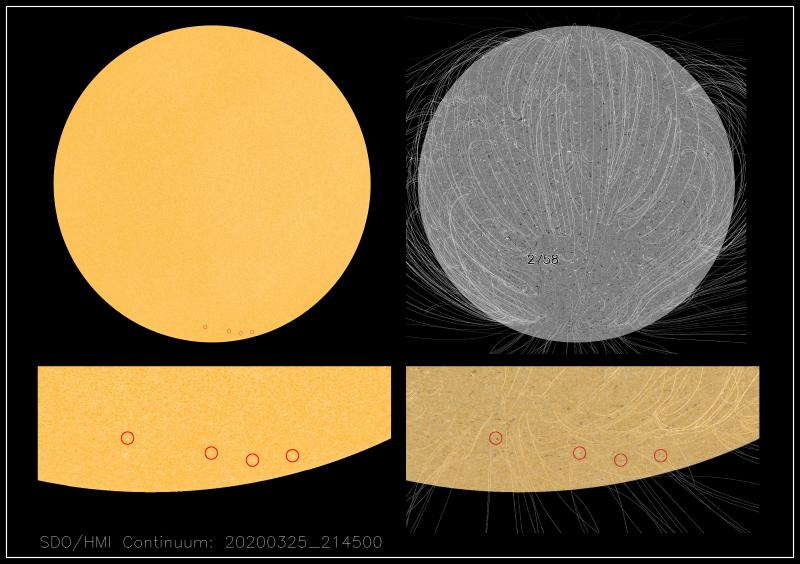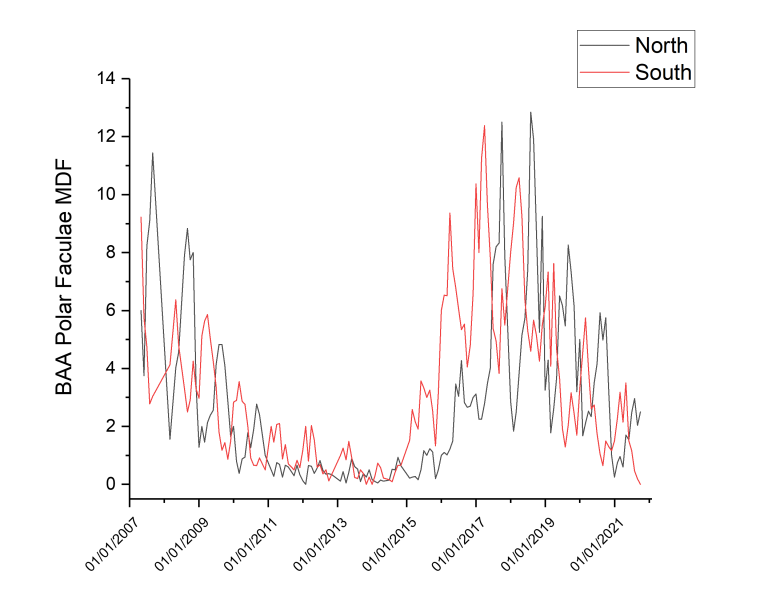Multiwavelength observation of polar faculae
2022 January 29

Introduction
Polar Faculae
‘Facula’ (singular) means ‘bright point’ or ‘little torch’ in Latin. In reality, these features of the solar surface (photosphere) as seen in white light (WL) tend to take the form of vein-like structures when observed near the limb of the Sun. They are caused by changes in the solar magnetic field. The Sun generates this field internally through the motion of electrically charged gases (plasma). This field is similar to that of a bar magnet, with a north and south pole. The magnetic field lines are fairly uniform at the poles but get stretched, pulled and amplified near the equator due to those latitudes’ faster rotation compared to the poles. Depending on the particular solar cycle, the magnetic field lines are directed outwards from the north pole and inwards at the south pole; this is then reversed in the next solar cycle as the Sun’s polarity flips every 11 years.1
Magnetic fields make their presence known on the solar surface by changing the gas dynamics and thereby developing either faculae or dark sunspots. The latter are the result of a strong magnetic flux stifling convection from below the photosphere, across a large area of the solar surface. The magnetic field lowers the gas pressure and makes the sunspot more transparent than the surrounding photosphere. This can be seen when the sunspot nears the solar limb as the ‘Wilson effect’, where an apparent deep depression or cavity-like appearance is observed. While viewing the evacuated magnetic regions of a sunspot, the observer can see a little deeper into the photosphere, giving the illusion of a depression.
Faculae however are the result of smaller (and perhaps weaker) magnetic regions on the solar surface, which do not inhibit convection over a large area. In faculae, as in sunspots, the magnetic field produces an extra pressure term which reduces the gas density and allows the observer to see deeper into the Sun. Unlike sunspots, the faculae do not suppress convective flows, so the observer sees deeper where the granulation pattern is hotter and brighter. When viewed near the limb of the Sun, the bright walls of the solar granulation are seen at a larger depth into the photosphere than the surrounding area.2,3 The scattered light from this leakage causes the faculae to be brighter and around a few hundred degrees warmer than the surrounding photosphere.4
The magnetogram in Figure 1, acquired on 2020 Mar 25 from the Solar Dynamics Observatory (SDO) Helioseismic & Magnetic Imager (HMI) instrument, shows the magnetic field lines and where they meet the polar surface (magnetic flux tube footpoints). Some polar faculae of interest are circled and show co-localisation with these magnetic field footpoints.
Faculae can be precursors to sunspots (in the zone 0–45° in latitude) and even after the sunspot has decayed, the bright faculae can last for several rotations in total. However, polar faculae are different to those in the sunspot zone. Found at their lowest latitude during solar minimum (60°), but on average at around 70–90° latitude, these small granular or elongated flakes can last from minutes to 1–2 days at the very most, making them more difficult to observe and study.4 Cortesi (1978) states that the average lifetime of polar faculae depends upon their size and magnetic field strength in gauss (Gs).5 Small faculae last 16 minutes or less (150–250Gs), medium for 39 minutes and large for 143 minutes or more, while large facular knots may last for 13 hours (900Gs).5,6 According to Müller (1954) and Waldmeier (1955), some polar faculae have lifetimes of many days.7–9 Some fluctuate, some disappear, and some reappear again in a few hours. Long-lived polar faculae are always bright (more likely to be observed by an amateur astronomer), but the converse does not follow; bright ones are not always long-lived.10
Together with the transitory nature of polar faculae making observations challenging, the tilt of the Sun relative to the Earth can also add difficulty. Observations of the solar poles from Earth are best in February/March, when the south pole is more inclined towards us, and in August/September, when the north pole is tilted towards us (Figure 2).

In addition, polar faculae are more frequent at solar minimum and at the sunspot cycle’s rising phase; they generally disappear from view around the time of sunspot maximum (Figure 3).12

Chromospheric features
Very little is known as to the relationship between polar faculae as observed in the photosphere and features observed in the chromosphere of the Sun. The chromosphere is traditionally defined as a layer 2,000km thick, at a height of around 500km above the photosphere.
Photospheric faculae at the poles and elsewhere on the Sun correspond to magnetic field footpoints (flux tube footpoints). These appear bright, as previously discussed, since they allow us to see slightly deeper into the Sun where it is hotter, and thus brighter (similar to the Wilson effect observed when a sunspot is seen near the limb).
Calcium II K (CaK) emission (lower chromosphere) comes from shock heating of the chromosphere as waves are channelled along the magnetic field lines. In the polar regions, the magnetic field is unipolar, and it does not usually reconnect with the solar surface. The wave motion is simple (radially upwards) and so the shock heating (and energy deposition) likely always corresponds to the same location as the photospheric bright points (magnetic flux tube footpoint). Thus, there is a close relationship between the photospheric features and those observed in the lower chromosphere (CaK).13 This has been a widely-held view since the 1950s–’70s, when many studies were published indicating that WL faculae and plage as seen in the chromosphere correlate very closely in shape and position; they probably represent the same structures but at different heights in the solar atmosphere.14
In hydrogen-alpha (H-alpha; mid-chromosphere), this becomes more complicated. What is observed dramatically depends on how broad the bandpass of the H-alpha filter used is, and at what precise wavelength in the line profile the observer is looking. In the red and blue wings of H-alpha, the evacuated magnetic flux tube can be seen (similar to WL), allowing observation deeper into the chromosphere or into the high photosphere and causing a bright appearance. However, at the line core the sides of mottles can be observed instead and so the feature may appear darker.
Figure 4 shows the same region of the solar limb in H-alpha, in both the blue wing on the left and centre-line (line core) on the right. The area enlarged is highlighted by a box in the main image. In the blue wing, we can see the mottles following the magnetic flux tubes (as seen also in Figure 5) which are dark (labelled ‘a’), and the flux tube footpoint, which is bright white (‘b’). At the line core, these mottles also appear dark (‘a’), but the magnetic footpoint is much more difficult to observe. At centre-line the bright areas are more commonly termed ‘plage’ (‘c’).
(Login or click above to view the full illustrated article in PDF format)
https://britastro.org/wp-content/uploads/2022/01/Figure-1-20200325_thumb.jpeg
https://britastro.org/wp-content/uploads/2022/01/Figure-1-20200325_thumb-1.jpeg
https://britastro.org/wp-content/uploads/2022/01/Figure-2_1.jpeg
| The British Astronomical Association supports amateur astronomers around the UK and the rest of the world. Find out more about the BAA or join us. |
